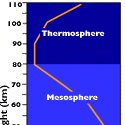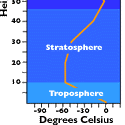

The atmosphere is the blanket of air and moisture that surrounds the Earth, extending out to distances in excess of 500 km. The atmsphere consists of six main layers, with density decreasing the further away from the surface. As density decreases so does the air pressure. Air pressure is the normal way to measure the quantity of a gas. The units used for air pressure is the kilopascal or kPa. Other units of pressure are millibars, millimeters or inches of mercury, torr and an atmosphere. Pressure guages or barometers are used to measure pressure.
Air pressure is caused by gas molecules that comprize air, stiking an object's surface. The more molecules that strike a fixed area, the greater the pressure. Hence the higher the altitude, the fewer the molecules, the less the pressure. This concept is based on Kinetic Molecular Theory.
In discussing weather, pressure is related to the weight of the air above the point at which the measurement is taken. This means that it must be highest at the Earth's surface and decreases continuouslly upward through the atmosphere.
The annual global mean-sea-level pressure is 1013.2 mbar or 101.32 kPa, which relates to a density of 1.23 kg/m3. At the top of the Empire State Building in New York, it is typically 5.3 kPa lower! At the top of Mount Everest the average pressure is 35.5 kPa at which a person could not survive.
The following is a chart of the various layers of the atmosphere
| troposhere | - closest to the Earth's surface - contains most of the air's moisture The lowest layer of the atmosphere is called the troposphere. It ranges in thickness from 8km at the poles to 16km over the equator. The troposphere is bounded above by the tropopause, a boundary marked by stable temperatures. Above the troposphere is the stratosphere. Although variations do occur, temperature usually declines with increasing altitude in the troposphere. Hill walkers know that it will be several degrees cooler on the top of a mountain than in the valley below. The troposphere is denser than the layers of the atmosphere above it (because of the weight compressing it), and it contains up to 75% of the mass of the atmosphere. It is primarily composed of nitrogen (78%) and oxygen (21%) with only small concentrations of other trace gases. Nearly all atmospheric water vapour or moisture is found in the troposphere. The troposphere is the layer where most of the world's weather takes place. Since temperature decreases with altitude in the troposphere, warm air near the surface of the Earth can readily rise, being less dense than the colder air above it. In fact air molecules can travel to the top of the troposphere and back down again in a just a few days. Such vertical movement or convection of air generates clouds and ultimately rain from the moisture within the air, and gives rise to much of the weather which we experience. The troposphere is capped by the tropopause, a region of stable temperature. Air temperature then begins to rise in the stratosphere. Such a temperature increase prevents much air convection beyond the tropopause, and consequently most weather phenomena, including towering cumulonimbus thunderclouds, are confined to the troposphere. Sometimes the temperature does not decrease with height in the troposphere, but increases. Such a situation is known as a temperature inversion. Temperature inversions limit or prevent the vertical mixing of air. Such atmospheric stability can lead to air pollution episodes with air pollutants emitted at ground level becoming trapped underneath the temperature inversion. |
| tropopause | a thin boundary layer temperature begins to rise because of an increase in ozone which absorbs ultraviolet radiation |
| stratosphere | The stratosphere is the second major layer of the atmosphere. It lies above the troposphere and is separated from it by
the tropopause. It occupies the region of atmosphere from about 12 to 50 km, although its lower boundary tends to be
higher nearer the equator and lower nearer the poles. The stratosphere defines a layer in which temperatures rises with increasing altitude. At the top of the stratosphere the thin air may attain temperatures close to 0°C. This rise in temperature is caused by the absorption of ultraviolet (UV) radiation from the Sun by the ozone layer. Such a temperature profile creates very stable atmospheric conditions, and the stratosphere lacks the air turbulence that is so prevalent in the troposphere. Consequently, the stratosphere is almost completely free of clouds or other forms of weather. The stratosphere provides some advantages for long-distant flight because it is above stormy weather and has strong, steady, horizontal winds. |
| mesosphere | The mesosphere (literally middle sphere) is the third highest layer in our atmosphere, occupying the region 50 km to
80 km above the surface of the Earth, above the troposphere and stratosphere, and below the thermosphere. It is
separated from the stratosphere by the stratopause and from the thermosphere by the mesopause. Temperatures in the mesosphere drop with increasing altitude to about -100°C. The mesosphere is the coldest of the atmospheric layers. In fact it is colder then Antarctica's lowest recorded temperature. It is cold enough to freeze water vapor into ice clouds. You can see these clouds if sunlight hits them after sunset. They are called Noctilucent Clouds (NLC). NLCs are most readily visible when the Sun is from 4 to 16 degrees below the horizon. The mesosphere is also the layer in which a lot of meteors burn up while entering the Earth's atmosphere. From the Earth they are seen as shooting stars. |
| thermosphere or ionosphere |
The thermosphere (literally "heat sphere") is the outer layer of the atmosphere, separated from the mesosphere by the
mesopause. Within the thermosphere temperatures rise continually to well beyond 1000°C. The few molecules that are
present in the thermosphere receive extraordinary amounts of energy from the Sun, causing the layer to warm to such
high temperatures. Air temperature, however, is a measure of the kinetic energy of air molecules, not of the total energy
stored by the air. Therefore, since the air is so thin within the thermosphere, such temperature values are not comparable
to those of the troposphere or stratosphere. Although the measured temperature is very hot, the thermosphere would
actually feel very cold to us because the total energy of only a few air molecules residing there would not be enough to
transfer any appreciable heat to our skin. The lower part of the thermosphere, from 80 to 550 km above the Earth's surface, contains the ionosphere. Beyond the ionosphere extending out to perhaps 10,000 km is the exosphere or outer thermosphere, which gradually merges into space. Technically, the ionosphere is not another atmospheric layer. It occupies the same region of the upper atmosphere as the thermosphere. In this region of the atmosphere the Sun's energy is so strong that it breaks apart molecules and atoms of air, leaving ions (atoms with missing electrons) and free-floating electrons. The ionosphere is the region of the atmosphere where the aurorae occur. Ionisation of air molecules in the ionosphere is produced by ultraviolet radiation from the Sun, and to a lesser extent by high-energy particles from the Sun and from cosmic rays. The large number of free electrons in the ionosphere allows the propagation of electromagnetic waves. Radio signals - a form of electromagnetic radiation - can be "bounced" off the ionosphere allowing radio communication over long distances. |
| exosphere | The exosphere is the highest layer of the atmosphere. Together with the ionosphere, it makes up the thermosphere. The exosphere extends to 10,000 km above the Earth's surface. This is the upper limit of our atmosphere. The atmosphere here merges into space in the extremely thin air. Air atoms and molecules are constantly escaping to space from the exosphere. In this region of the atmosphere, hydrogen and helium are the prime components and are only present at extremely low densities. This is the area where many satellites orbit the Earth. |
How temperature varies as altitude increases. A small diagram plotting temperature vs altitude.


More information can be found from the site source of this note at
Check out all the topics on the right hand frame set of this site.